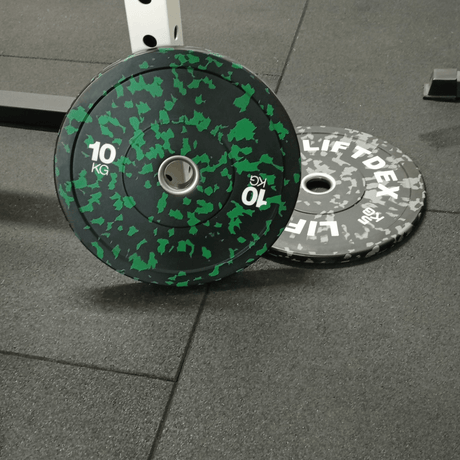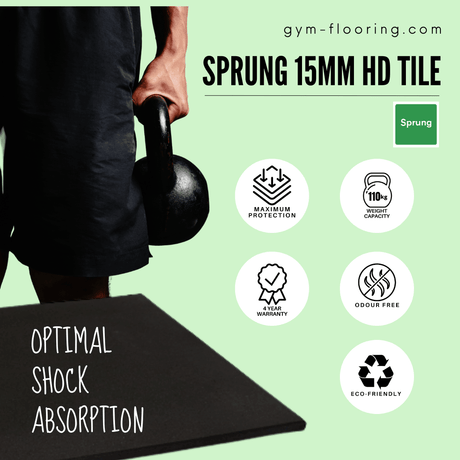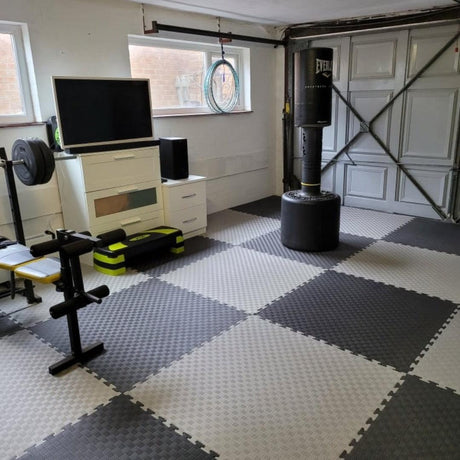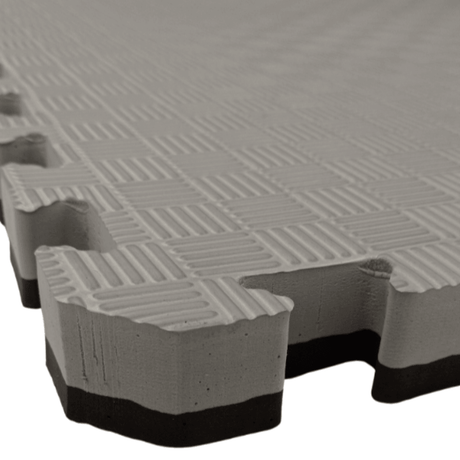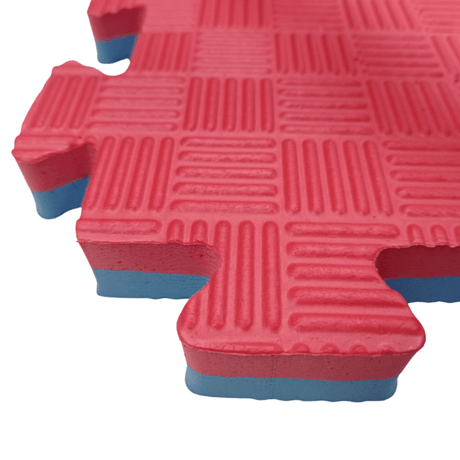When choosing flooring for your gym, there’s a lot to think about. The flooring has to withstand heavy use, be easy to clean and look and feel hygienic.
In this post we’ll look at the best gym flooring for commercial gyms and home gyms, narrowing down the options to help you decide what's best for your space.
Table of Contents
Why Gym Flooring Matters

Durability
Gym flooring has to be tough enough to withstand daily use and the impact of equipment and exercise. It should not dent, scratch or wear down.
Ease of Clean
A clean gym floor prevents dirt and bacteria building up, a safe workout environment. Low maintenance options are good for both commercial and home gyms.
Aesthetics
Your gym flooring sets the tone for the space, makes it look and feel inviting and motivating for users.
Performance
A gym surface should support the user during exercise, be comfortable and allow trainers to focus on their workout while enhancing performance.
Gym Flooring Options

1. Rubber Flooring
Rubber floor mats are the go to choice for many gyms, for their durability, versatility and impact absorption. Popular in CrossFit and Olympic weightlifting facilities, rubber protects both equipment and users and reduces noise from heavy impacts.
Pros:
- Tough and impact resistant
- Non slip surface
- Easy to clean and maintain
- Available as mats, tiles or rolls for flexible installation
Best Uses:
- Home gyms
- Weightlifting zones
- High traffic areas
Rubber interlocking mats are great for DIY projects and are a good gym mat for home use as well as for commercial fitness facilities. They come in various colours and thicknesses for domestic and commercial use. For open-plan, cardio areas, rubber roll is a great option. It covers more space and comes in less thick options for equipment and body support rather than protection from free weights.
2. Foam Flooring
Foam gym flooring provides cushioning and shock absorption, good for certain sports and activities. Eva Foam Mats are great for martial arts, boxing and other high impact activities where comfort and protection is key.
Pros:
- Inexpensive and lightweight
- Easy to install with interlocking tiles
- Soft surface, reduces friction burns
Best Uses:
- Martial Arts Studios
- Boxing Gyms
- Home Exercise Spaces
Foam isn’t as tough as rubber but is great for less weight bearing workouts or activities that require a softer surface.
3. Vinyl Flooring
Vinyl flooring is a durable and hygienic option used in larger sports halls and recreation centres. It is not commonly used in fitness applications as it does not withstand the impact of weights as well as rubber and can easily become damaged.
Pros:
- Easy to clean and maintain
- Various designs and colours
- Professional looking
Best Uses:
- Multi-Purpose Sports Halls
- School Gyms
- Dance Studios
4. Gym Turf & Tracks
Gym turf is a durable artificial grass surface used for specific gym areas such as sprint tracks, sled pulling lanes and functional training zones.
Pros:
- Tough with strong fibres
- Colours to enhance gym look
- Adds to training space versatility
Best Uses:
- Functional Fitness Areas in Commercial Gyms
- Speed Training and Agility Centres
Things to Consider When Choosing Gym Flooring

1. Activities and Equipment
What kind of workouts or sports will your gym support? High impact activities like weightlifting need thick and durable rubber flooring whereas a boxing gym may need more resilient and cushioned flooring. Thickness is also a key factor. Consider the level of activities and impact you will be doing and choose a suitable floor thickness.
2. Existing Space and Subfloor
Where is your gym and how much space do you have available? Consider the shape and size of the space to determine the installation requirements and any preparation work that may need carried out.
3. Maintenance
Some flooring types require more maintenance than others. Rubber flooring is low maintenance while other floor materials such as wood, vinyl and carpet require more care.
4. Colour and Design
The look of your gym matters. Dark colours like black gym tiles or grey are practical and hide dirt well while also looking sleek and professional. A brighter colour scheme can create a more dynamic and energetic environment so opt for flooring that matches your gym aesthetic.
5. Budget
Cheaper flooring may save you money upfront but investing in good quality gym flooring will save you money in the long run by reducing the need for replacements.
How to Clean Gym Flooring

FAQs About Gym Flooring
What is the best flooring for a gym?
Rubber flooring is the most versatile option, suitable for most workout types and providing excellent durability and safety.
What is the most popular gym flooring?
Rubber remains the top choice due to its durability, ease of cleaning, and versatility.
How thick should gym flooring be?
Rubber rolls typically range from 4mm to 12mm for general use, while weightlifting zones may require tiles up to 63mm thick for maximum protection.
How long does gym flooring last?
With proper maintenance, rubber flooring can last over 10 years, making it a cost-effective choice.
Final Thoughts
Choosing the right gym flooring is vital for creating a safe, functional, and appealing workout space. Rubber flooring is a versatile and durable option suitable for most gyms, while foam and vinyl offer alternatives for specific needs. Synthetic turf adds a dynamic element for functional training zones.
No matter your choice, investing in high-quality materials tailored to your space and activities will ensure your gym flooring performs well and lasts for years.
Needing a gym flooring upgrade? Discover exciting surface solutions for commercial gym flooring and floor mats for home gyms.





